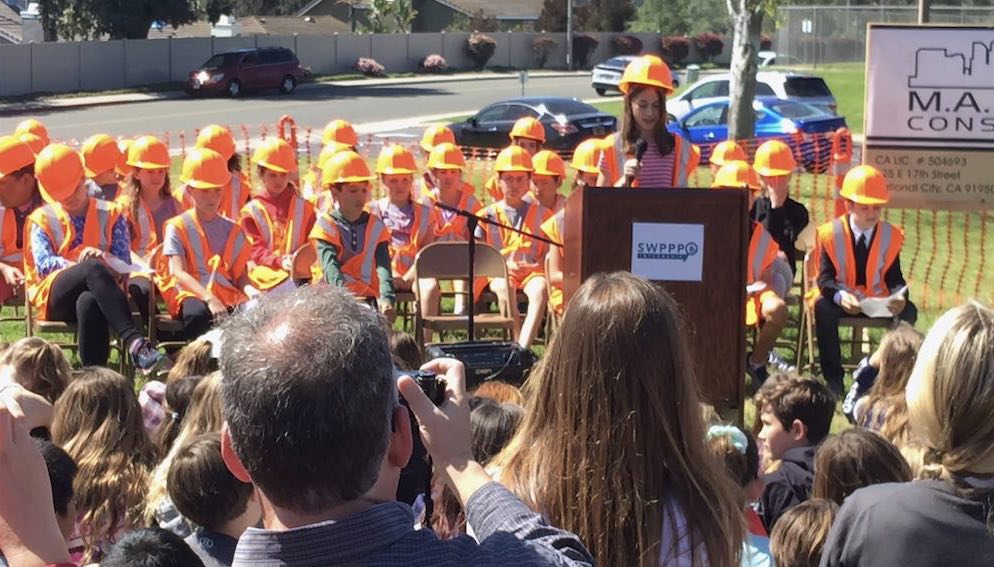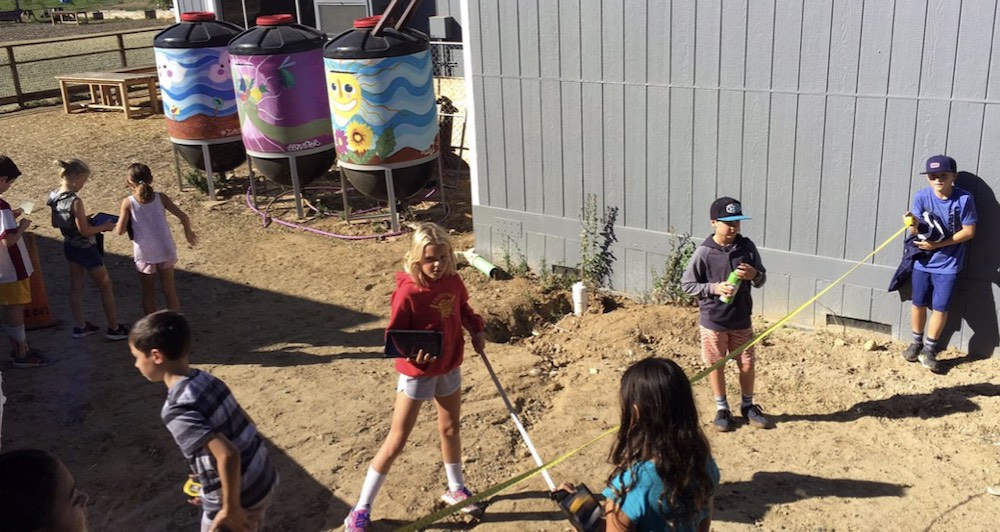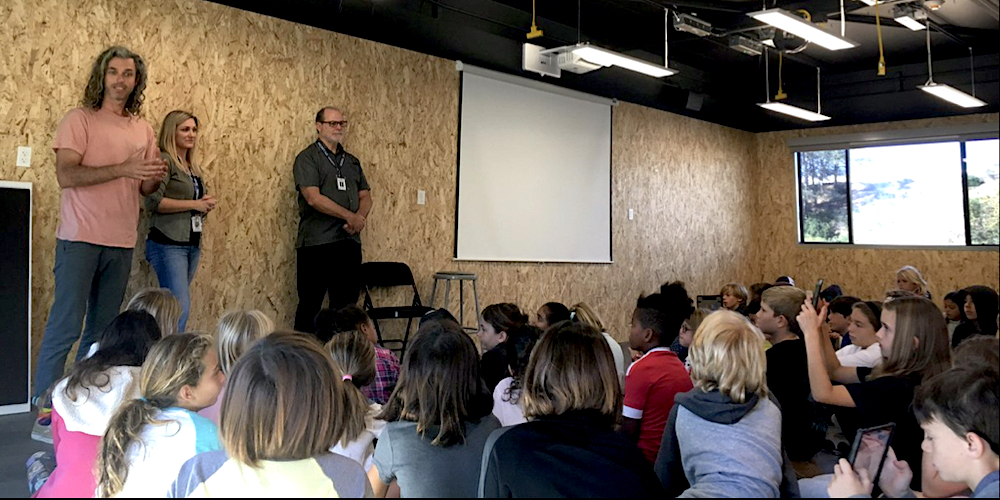An interview with Timothy Baird, Ed.D.
Timothy Baird, Ed.D., recently retired from his position as Superintendent of the Encinitas Unified School District. As Superintendent, Dr. Baird led the implementation of a one to one digital learning program, which includes a suite of digital curriculum, for all students. EUSD has been recognized for two consecutive terms as an Apple Distinguished Education Program.
Dr. Baird’s leadership in green initiatives and environmental stewardship has garnered state and national recognition for the district’s conservation efforts, including selection by the U.S. Department of Education as a National Green Ribbon District. In addition, EUSD has developed and implemented an award-winning, comprehensive Health and Wellness Program that incorporates yoga and character education classes for all students. He was part of the team that helped develop California’s Blueprint for Environmental Literacy, and continues to be involved in its implementation of the state’s Environmental Principles and Concepts through the California Environmental Literacy Initiative.
Dr. Baird was a keynote speaker at the 2019 Green California Schools and Community Colleges Summit. In a Green Technology interview, he talks about how the district has approached sustainability, and some of the innovative things it has done to integrate its facility and curriculum programs.
While many California schools are ahead of the curve in regard to sustainability, more needs to be done. Where do things stand compared to where they need to be?
We’ve made some great progress in regard to things like green ribbon schools and school districts. The California environmental literacy initiative has really brought things together, moving environmental literacy into the frameworks. That’s all moving schools and school districts in the right direction.
But I don’t see those efforts being connected. There may be great work happening in a district there and a county there, but we’re all kind of starting from scratch and not learning from each other like we should be.
That’s beginning to change. I do see county offices of education that are doing some incredible things. Alameda is doing good work. San Mateo is doing good work. Down here in San Diego we’re starting to pull together some of the environmental work and that will help promote some of these things and connect districts. There are networks like the CAELI Network and the national green schools network that are connecting districts, showcasing best practices. The Green California schools conference that you put on is a great place to highlight this work.
It shouldn’t be a thousand districts working independently. We should be learning from each other, sharing what we’re doing and getting some synergy that can move this work forward.
What kinds of things prevent districts from really committing to green practices?
We ask ourselves that all the time when we’re looking at how we can move this work forward. A lot of things have to go right for green practices to get into place, and all it takes is for just a couple of things to go wrong to derail efforts.
First and foremost, it’s about leadership—both district leadership and site-level leadership. You have to have leadership that promotes green practices. Not just the superintendent, but the facilities director, the purchasing director, the business person. All of these matter. You can say “we’re a green school district,” but if your facilities director doesn’t get that and isn’t incorporating green practices into their work you’re not really a green school district.
You’ve got to have things happening on all the different levels. You can set goals at a district level, but if they’re not being promoted and championed at the site level, then nothing’s really happening. That’s one of the big problems I see.
Even when a district starts down this pathway, if it doesn’t get embedded into the district goals, if it doesn’t get embedded into the budget, sustainability can fall off the table if the next superintendent wants something different.
I also think that sometimes districts mistakenly don’t connect green programs to the “real” work of school districts. It’s viewed as an extra thing. Districts that are really doing this work understand that is part of their central practice. They understand that there is an educational component. They understand that it’s not just the right thing to do but it also can save them money.
This is not “extra.” That perception needs to change.
Last September, Governor Brown signed a bill into law that deepened the state’s commitment to environmental literacy, embedding it in the education code. Obviously, this will affect curriculum moving forward – but will it also affect facility projects?
When you embed environmental literacy into our science framework, our history framework, and the health framework, more people will begin to see that this is how we do school in California. It’s a fairly short jump from there to looking at the facility side.
Sometimes we separate the facility side from the educational side because we don’t see that connection, but there’s a huge connection here. Everything we do on the facility side has an educational component.
When there’s new construction, I think that school districts are being thoughtful about that and trying to do the right thing. Where this gets real interesting is in regard to what we are doing about existing facilities, how we are updating them to be greener, to save energy, to save resources, to be more efficient.
As our district went through a modernization, we did it through a green lens. We put in solar tubes in all of our schools. We’ve figured out how to do water harvesting and keep as much water on the campus as much as possible. We looked for outdoor learning spaces.
That was a thought process from an educational side, but we were linking it to the facility side. I think more and more school districts are doing that as they’re looking at their existing facilities.

What can districts gain by looking for curriculum opportunities in an energy or building project?
Initially we thought about it from an educational side. If you just put up solar panels and you then don’t bring that back into the classroom, you’re totally wasting an educational opportunity.
When we first put up the solar panels and we started going about our business, kids started saying, “What are those, why are they up there? What are they doing for us?”
It was obvious – of course, this is an educational opportunity. We brought solar panels into classrooms. We had kids go out and look at them. We started measuring the difference in energy use before and after the installation. We brought energy bills into the classrooms and had kids look at what the solar panels were doing. There was a powerful lesson on energy just because we put in solar panels.
School districts miss these opportunities when they do things on the facility side and don’t tie them to the educational side. Now, everything that Encinitas does facility-wise, practice wise, policy wise, everything related to the environment is treated as a learning opportunity.
I mentioned the solar example. We did the same thing with solar tubes. We brought solar tubes into classrooms so kids could see them. They learned the science behind the solar tube and how it brought more light into the classroom. We talked about natural light versus artificial light. We did studies and got feedback from kids who were in classrooms that had solar tubes versus ones that weren’t.
Students helped design bioswales on their campuses because they were worried about water runoff and how waste was getting into the oceans. They figured out how we could solve that problem. They looked at different filters for our water drains, they looked at ways to keep trash from those areas.
We had a company come in that wanted to install LED lighting. We said, “Great. We want to do a pilot study and have kids measure results of the LED energy output versus the lights that we have in there currently.” We did a whole study with that company.
We’ve decided to use ionized water for cleaning. Our custodians didn’t think water could clean as well as bleach. So we did science experiments with them, and had them measure the amount of germs that were on a desk before and after cleaning with our regular cleaning products, and then our ionized water cleaning product. They were amazed. That’s what it took to convince them that this tool actually worked.
Every time we make an environmental change, we try to tie it back to, “What can we learn from this? How can we track this? How can we set up a science experiment that shows the difference we’re making by doing this work?”
How have students responded to this?
Once we started setting up these learning opportunities for kids, kids started doing their own. We had kids come to our school board and say, “How come we’re not recycling these marking pens? We’ve done some research and Crayola will recycle them if we send them in this way and do this.” Then we had kids came to the district and said, “You’ve got plastic straws and sporks and the lunch packaging. That’s wasteful and we need to be looking at new products to replace them.” They did their own research about other options.
Kids actually helped design two of our new classrooms. They had to use a green focus, and they had to stay within budget. They researched the companies and the types of furniture and materials that were going to be used in those classrooms. Now we’re now outfitting those classrooms and using those students’ plans and drawings, and the spreadsheets that they created.
It’s gone beyond us creating learning opportunities for kids. Now they’re bringing new things to us. It’s turning into us learning from students about what we should be doing.
Have projects that engage students in this way helped attract funding for the district?
Sometimes that does happen. We have a great example of that. A group of students that were working on the classroom project really liked a product, but it was too high for their budget. They called the company and talked to the owner of the company. They explained who they were and said that they wanted to purchase the product, but it was too expensive. The owner came down in price for them.
That’s just one example. We’ve had very generous donations from companies. The LED company that we’re working with donated the lights for six classrooms because they could then use them as a model that would help them show other school districts that this makes a difference. We only paid for the installation.
What should companies be doing to support these kinds of connections?
It could be daunting task for company to that they have to write a full-blown curriculum. I don’t think you have to work that hard. Just having some really interesting learning questions that get students started along this pathway can be enough. And then maybe offering up your services to come in and speak with classrooms and be part of the learning efforts.
More and more schools are trying to look at inquiry-based learning as a tool to really engage students. What if the company came in and said, “Here’s what we sell, here are some ways that other schools have used this to enhance learning. Here are some really fun, interesting questions to start engaging students down this pathway.”
That would be a really interesting thing to try. Then there’s the extra step of companies putting themselves out there to do things like help run a pilot study, or to come in and present to classrooms or do demonstrations for students. That’s a whole other layer of customer service that would make a huge difference.

Would those kinds of things change how a district saw companies or make them feel more excited about that relationship?
I think so. I really do. Unfortunately, sometimes it’s about who’s got the lowest price, who’s going to save me the most money. But more and more we are seeing these things turn into learning projects that really engage students and teachers, and change the way that we approach learning in our classrooms. I think more school districts will start saying that it’s important to have a learning opportunity as well as a new product.
Right now, we look for that. If the, if the company doesn’t offer that, we often say, “Well, would you be willing to come to talk to students? They’re going to want to investigate how this saves us energy.”
I’m finding that companies love doing that. I see a win-win here, and over time I think this is going to be something that districts will start to expect.
It’s not necessarily obvious that educators have a role in facility decision making. As more attention is focused on learning opportunities in facility projects, are their voices becoming more important?
I believe that we’ve left educators out of these conversations for too long. You can’t base all of these facility decisions on short term-thinking related to what’s the cheapest option, what saves me the most money next year.
We really have to expand this into a longer-term thought process. Getting educators involved in helping to do the research on what are the right products, and what we should be looking at as we’re thinking about facility improvements, is a natural fit. Bringing teachers into that conversation and then having teachers bring students in that conversation is really a direction we all should be taking.
Will the need to incorporate the focus in Environmental Principles and Concepts in curriculum bring further interest in making these connections?
It definitely will. This is a way to bring students into the learning. They learn about a science concept and then they can actually apply it to something that is being done on their campus that helps the environment. What a brilliant way to tie that learning together.
There’s so much good work happening out there. I know some of the people involved and what they’re doing, but it’s only when you come to an event like the Green California schools conference that you really look in depth and you start to connect at a different level.
My overall hope is that we recognize that we’re not alone in this work, that there are other people doing similar, and in many cases better, work in this area and we start connecting with them. We can change the whole dynamic from a thousand stand-alone districts to many of us working together, sharing the best practices, best ideas, seeing how other districts are approaching the work.
I’m working with the California Environmental Literacy Initiative network and Ten Strands to help make this happen. California is doing some amazing work. We just need to bring it together, showcase it, and then help lead the nation.
Thank you.

